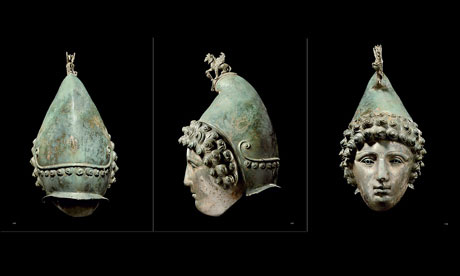A stunning Roman cavalry helmet, made to awe the spectators in a procession of wealth and power rather than for practical use in combat, has been found by a metal detector user near the village of Crosby Garrett in Cumbria.
However, the artefact is not certain to end up in a local museum as single items of bronze are not covered by the Treasure Act.
Instead the helmet, the best found in Britain in more than a century, is likely to make its finder rich at auction, with a guide price at Christie's of £300,000.
Tullie House in Carlisle, which has an important Roman collection, is desperate to acquire the helmet with the backing of the British Museum, but faces an uphill battle to match bidders at next month's sale. One expert believes the helmet could go for £500,000 or more.
The bronze helmet, which was originally tinned so it would have shone like silver, is modelled as the head of a handsome young man with curly hair, wearing a Phrygian cap - later adopted as the symbol of many revolutionary movements - topped with a griffin.
Although unquestionably a treasure, it is not covered by treasure law which would give a British museum the automatic right to acquire it by paying compensation to the finder and land owner. The old Treasure Act applied only to gold and silver. The new law includes bronze, but only when it is found in hoards. A heap of corroded bronze axes found on a Dorset hilltop two years was declared treasure, but the helmet cannot be so classified.
The finder, who is from the north-east and in his early 20s, has been detecting with his father for several years. He has found small pieces, including a few Roman coins, on a Cumbrian farm which is near a Roman road but miles from the nearest recorded Roman site. When he found the helmet face down in mud on the farm in May he first thought it was a Victorian ornament.
He reported the find to the Portable Antiquities Scheme at the British Museum, a voluntary scheme encouraging metal detectors to report all archaeological finds, but has now exercised his right to send it straight to auction.
If Tullie House is outbid, as seems inevitable, export of the helmet is likely to be temporarily barred by the government to give a British museum the chance to match an overseas buyer's bid.
Roger Bland, head of Portable Antiquities, said: "This is an internationally important find and one which everyone agrees should be in a museum in this country and we are supporting the efforts of Tullie House museum in Carlisle to acquire it."
The Portable Antiquities Scheme played an essential role in working with the finder to discover exactly where the helmet was found, he said.
The helmet will be offered in Christie's antiquities sale on 7 October. The catalogue describes it as "an extraordinary example of Roman metalwork at its zenith" which is set apart by its beauty, workmanship and completeness. "In addition the remarkable Phrygian-style peak surmounted by its elaborate bronze griffin crest appears unprecedented," it says.
The catalogue notes that the only two other helmets have been found in Britain complete with face masks - the Ribchester helmet, found in 1796 and now in the British Museum, and the Newstead helmet found in 1905 and now in Edinburgh.
The helmet was found in more than 30 pieces, but has been restored and cleaned for sale by Christie's. Archaeologists fear clues on how it came to be buried in rough land may have been destroyed in the process.
"It is a pity that the object was restored before there was any opportunity to examine it scientifically, as that would have given us more information about how it came to be in the ground," Bland said. "We hope it will be possible for there to be an archaeological examination of the find spot."
Metal detecting and Roman history sites have been buzzing with the news of the find for days, with many enviously describing it as the find of a lifetime, and some comparing it in importance to the Anglo Saxon helmet found in the Sutton Hoo ship burial.
Paul Barford, a British archaeologist working in Warsaw, Poland, is a bitter critic of the PAS scheme, believing that it encourages rather than controls treasure hunting. He writes on his blog: " I say let the Crosby Garrett helmet go abroad. Let it be an easily understood symbol for the people of the British Isles just how their archaeological heritage is being squandered by those who should be protecting it."










